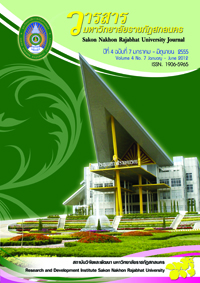การพยากรณ์การแพร่เชื้อโรคเลปโตสไปโรซิสในจังหวัดสกลนคร
Abstract
บทคัดย่อ
โรคเลปโตสไปโรซิส (Leptospirosis) เกิดจากการติดเชื้อแบคทีเรียรูปเกลียวสว่านในสกุล "เลปโตสไปร่า" เป็นโรคติดเชื้อจากสัตว์สู่คนที่เป็นปัญหาสาธารณสุขของประเทศไทย แบคทีเรียสามารถแพร่เชื้อทางตรงไปสู่คนหรือระหว่างสัตว์รังโรคจากการสัมผัสปัสสาวะหรือเนื้อเยื่อของสัตว์ที่ติดเชื้อ หรือสามารถแพร่เชื้อทางอ้อมผ่านการสัมผัสสิ่งแวดล้อมที่ปนเปื้อนเชื้อ ในการวิจัยครั้งนี้ ผู้วิจัยศึกษาภววิทยาของโรคเลปโตสไปโรซิสในคนโดยใช้ระเบียบวิธีทางวิทยาการระบาดและพยากรณ์อัตราป่วยด้วยเทคนิคการวิเคราะห์อนุกรมเวลาโดยตัวแบบกระบวนการถดถอยในตัวเองบูรณาการกับค่าเฉลี่ยเคลื่อนที่แบบมีฤดูกาล (Seasonal autoregressive integrated moving average model; SARIMA) ของข้อมูลตั้งแต่เดือนมกราคม พ.ศ. 2542 ถึงเดือนธันวาคม พ.ศ. 2550 และตรวจสอบข้อมูลในปี พ.ศ. 2551 ผลการวิจัยแสดงให้เห็นว่าอัตราป่วยมีความสัมพันธ์อย่างมีนัยสำคัญกับปัจจัยภูมิอากาศและตัวแบบ SARIMA (1,0,0)(0,1,1)12 ไม่เพียงแต่พยากรณ์ได้เหมาะสมกับข้อมูลในอดีตแต่สามารถพยากรณ์ข้อมูลอนาคตได้ด้วย
Abstract
Leptospirosis, which is caused by one of several strains of bacterium spirochetes of thegenus Leptospira, is a zoonotic disease and an emerging public health problem in Thailand. Thebacterium can be transmitted either directly through contacts to human or between reservoirhosts with urine of carrier animals or indirectly via contact with contaminated environment. Inthis work, we consider ontology of human leptospirosis, using a variety of epidemiological andforecast leptospirosis incidence using time series analysis. Seasonal Autoregressive IntegratedMoving Average (SARIMA) has been developed on the monthly data collection from January1999 to December 2007 and validated using the data in 2008. Our results indicate thatleptospirosis incidence is significantly associated with climatic factors, and show that theSARIMA (1,0,0)(0,1,1)12 is not only the fittest model but also make prediction based on theleptospirosis dataset.









